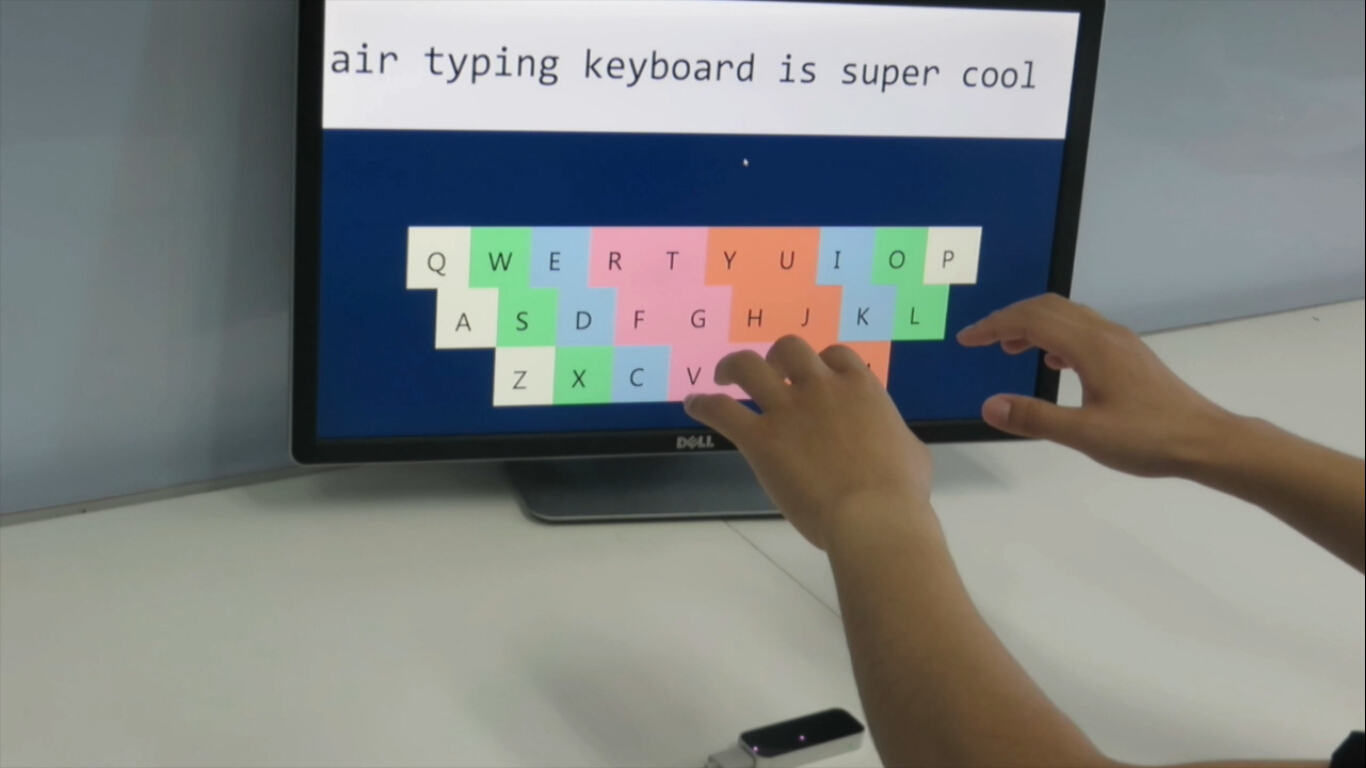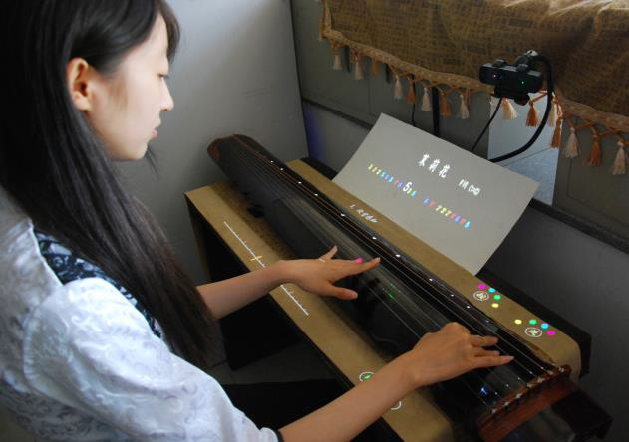论文成果 / Publications
2016
Investigating Effects of Post-Selection Feedback for Acquiring Ultra-Small Targets on Touchscreen
Abstract
In this paper, we investigate the effects of post-selection feedback for acquiring ultra-small (2-4mm) targets on touchscreens. Post-selection feedback shows the contact point on touchscreen after a user lifts his/her fingers to increase users' awareness of touching. Three experiments are conducted progressively using a single crosshair target, two reciprocally acquired targets and 2D random targets. Results show that in average post-selection feedback can reduce touch error rates by 78.4%, with a compromise of target acquisition time no more than 10%. In addition, we investigate participants' adjustment behavior based on correlation between successive trials. We conclude that the benefit of post-selection feedback is the outcome of both improved understanding about finger/point mapping and the dynamic adjustment of finger movement enabled by the visualization of the touch point.
计算机学报|基于语义的英文短语检索与搭配推荐及其在辅助ESL学术写作中的应用
Abstract
学术菜英文写作对干母语非英语的(English as a Second Language.ESL)学者而言是一项挑战,现有的ESL写作辅助系统均基于连续单词(n-gram)在语料库中出现的频率来构建,而忽略了语义信息对于ESL写作的作用. 文中提出基干语义的写作辅助方法。支持按照词性、搭配类型和概念扩展等语义条件来检索短语和自动推荐搭配,此外,为了方便英语知识有限的 ESL 学者利用语义条件进行检索,文中还设计了易于理解的短语检索界面.该界面提供包含语义修饰符的查询表达式,并可根据用户输入的部分查询表达式在线提示和补全.最后,为验证语义方法的有效性,文中实现并部署了ESLWriter 系统.用户实验表明,ESLWriter 可以有效地推荐搭配并提供短语检索结果,其查询界面直观易用;ESL.学者通过混合使用自动搭配推荐功能和短语检索功能,写作质量和写作信心得到有效提高.这些结果证明了语义信息在ESL写作辅助中的重要作用.
2015
ATK: Enabling Ten-Finger Freehand Typing in Air Based on 3D Hand Tracking Data
Abstract
Ten-finger freehand mid-air typing is a potential solution for post-desktop interaction. However, the absence of tactile feedback as well as the inability to accurately distinguish tapping finger or target keys exists as the major challenge for mid-air typing. In this paper, we present ATK, a novel interaction technique that enables freehand ten-finger typing in the air based on 3D hand tracking data. Our hypothesis is that expert typists are able to transfer their typing ability from physical keyboards to mid-air typing. We followed an iterative approach in designing ATK. We first empirically investigated users' mid-air typing behavior, and examined fingertip kinematics during tapping, correlated movement among fingers and 3D distribution of tapping endpoints. Based on the findings, we proposed a probabilistic tap detection algorithm, and augmented Goodman's input correction model to account for the ambiguity in distinguishing tapping finger. We finally evaluated the performance of ATK with a 4-block study. Participants typed 23.0 WPM with an uncorrected word-level error rate of 0.3% in the first block, and later achieved 29.2 WPM in the last block without sacrificing accuracy.
ChinAR: Facilitating Chinese Guqin Learning through Interactive Projected Augmentation
Abstract
The Guqin, a seven-stringed fretless zither, is the most representative traditional musical instrument in China. However, the complexity of its unique notation and theory has severely limited its popularity in the modern world. With the goal of providing an easy and effective way of learning Guqin, we have created an interactive learning system called ChinAR which employs augmented reality. We have made three main contributions in this paper: (1) a systematic method to design for instrumental learning combing eastern and western musical concepts; (2) a primary validation of the effect of augmented reality in facilitating learning of the Chinese Guqin (3) a natural user interface for the learning system applying gesture detection. The result of user study shows our design is helpful in providing better learning experience and enhancing performance and memorization with markedly less time spent learning. This work shows how a new interface helps promote the use of heritage instruments and culture.
A Tabletop-Centric Smart Space for Emergency Response
Abstract
This article describes the design and implementation of a smart space for emergency response based on five system design guidelines. A large-scale interactive tabletop with dedicated software serves as the center for collaboration. Information on the tabletop and peripheral devices can be shared via a user interface sharing technique. The authors deployed their smart space in a forest fire simulation and evaluated team performance in comparison with a control group. Analysis of the results reveals that this smart space can significantly improve team performance as well as team cognition. This article is part of a special issue on smart spaces.
2014
FOCUS: enhancing children's engagement in reading by using contextual BCI training sessions
Abstract
Reading is an important aspect of a child's development. Reading outcome is heavily dependent on the level of engagement while reading. In this paper, we present FOCUS, an EEG-augmented reading system which monitors a child's engagement level in real time, and provides contextual BCI training sessions to improve a child's reading engagement. A laboratory experiment was conducted to assess the validity of the system. Results showed that FOCUS could significantly improve engagement in terms of both EEG-based measurement and teachers' subjective measure on the reading outcome.
TangramTheatre: Presenting Children's Creation on Multimodal Tabletops
Abstract
The tangram is a jigsaw-like traditional Chinese art form rich in wittiness and expressiveness. However, there is an absence of efficient support to create animations for children and novice users after designing tangram characters. Thus, we present TangramTheatre, a performance-driven animation tool that combines both creation and animation of physical and virtual characters. TangramTheatre allows users to create characters using seven physical tangram pieces as what they do in real tangram games and then edit animations of these characters. In this paper we present our proof of concept prototype. A preliminary study was conducted to direct a future empirical study with children. The results show that all of the participants express great interests in TangramTheatre.
BodyRC: Exploring Interaction Modalities Using Human Body as Lossy Signal Transmission Medium
Abstract
With the increasing popularity of wearable computing devices, new sensing techniques that enable always-available interaction are highly demanded. In this paper, we propose Body RC, a novel body-based device using human body as lossy signal transmission medium. This device supports on-body interaction and body gesture recognition. In particular, Body RC recognizes the operations of on-body interaction and body gestures by analyzing the electrical properties when transmitting single high frequency analog signal through human body. We evaluate the capabilities and performance of Body RC through two controlled experiments showing robust classification of both on-body interaction and body gesture recognition. In addition, we design a real-time recognition system demonstrating the utility of our technique.
QOOK: enhancing information revisitation for active reading with a paper book
Abstract
Revisiting information on previously accessed pages is a common activity during active reading. Both physical and digital books have their own benefits in supporting such activity according to their manipulation natures. In this paper, we introduce QOOK, a paper-book based interactive reading system, which integrates the advanced technology of digital books with the affordances of physical books to facilitate people's information revisiting process. The design goals of QOOK are derived from the literature survey and our field study on physical and digital books respectively. QOOK allows page flipping just like on a real book and enables people to use electronic functions such as keyword searching, highlighting and bookmarking. A user study is conducted and the study results demonstrate that QOOK brings faster information revisiting and better reading experience to readers.








